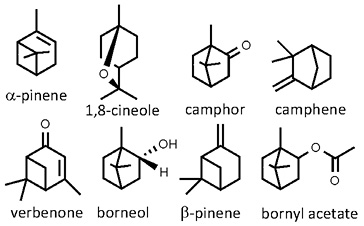 Rosmarinus officinalis
Rosmarinus officinalis
rosemary
Back to “Culinary herbs: rosemary (Rosmarinus officinalis)*”
Rosmarinus officinalis L. (Lamiaceae); roosmaryn (Afrikaans); romarin (French); Rosmarin (German); rosmarino (Italian); roméro (Spanish)
DESCRIPTION Rosemary leaves are needle-shaped, dark green above and pale white below, with rolled-in margins. They have a pungent, bitter taste and a strong spicy and slightly camphorous aroma.
THE PLANT An aromatic, evergreen shrub with small, two-lipped flowers that are usually blue or purple but sometimes pink or white.
ORIGIN The plant is indigenous to the Mediterranean region.1 Rosemary is linked to many myths and legends dating back to ancient Greece and Rome. It features in the mythology of Aphrodite, the Greek goddess of love and beauty, was recommended by Dioscorides as medicinal plant and was often used in wedding and funeral rituals.1 Rosemary is associated with fidelity, perhaps inspired by the famous quote from Shakespeare’s Hamlet (Act IV, scene 5, Ophelia to Laertes): “There’s rosemary, that’s for remembrance, pray love, remember.” Today it is one of the most important of all culinary herbs and of major commercial importance for home cooking2 as well as industrial food processing.3,4
CULTIVATION Rosemary is an old favourite in herb gardens, easily propagated from stem cuttings. It can withstand moderate frost and is exceptionally drought tolerant. Erect and robust cultivars such as ‘Tuscan Blue’ are particularly productive. It grows well in containers and can be trimmed into various shapes or clipped to form a low hedge.
HARVESTING The leaves are harvested (by hand or mechanically) and are sold fresh or more often in the form of a dried and packaged spice herb. The leaves may be steam-distilled to produce rosemary essential oil.3,4
CULINARY USES Leaves are used sparingly to flavour all types of meat dishes (venison, beef, lamb, pork, veal, poultry, grills, sausage meats, ragouts, stews, pâtés and marinades), as well as sauces, soups, salads and salad dressings.2 It goes well with pasta sauces, baked fish and vegetables, and can be used to flavour herb butter or milk used for a dessert.2 The bright blue flowers make an attractive garnish for salads or when candied, on cakes and other confectionery. Rosemary is one of the herbs used as ingredient of Benedictine. Rosemary oil is used in the production of alcoholic and non-alcoholic beverages, confectionery, condiments, relishes and processed meats.3,4
FLAVOUR COMPOUNDS Steam-distillation yields rosemary oil, with 1,8-cineole, α-pinene, camphor and β-pinene as main compounds.4 Depending on the chemotype, oil obtained by extraction may yield relatively high levels of minor compounds such as camphene, borneol, verbenone and bornyl acetate, all of which contribute to the complexity of the aroma.5

NOTES Rosemary essential oil is used in perfumery, soaps, bath oils, detergents, cosmetics and aromatherapy.3,4
1. Mabberley, D.J. 2008. Mabberley’s plant-book (3rd ed.). Cambridge University Press, Cambridge.
2. Larousse. 1999. The concise Larousse gastronomique. Hamlyn, London.
3. Farrel, K.T. 1999. Spices, condiments and seasonings. Aspen Publishers, Gaithersburg, USA.
4. Harborne, J.B., Baxter, H. 2001. Chemical dictionary of economic plants. Wiley, New York.
5. Santoyo, S., Cavero, S., Jaime, L., Ibañez, E., Señoráns, F.J., Reglero, G. 2005. Chemical composition and antimicrobial activity of Rosmarinus officinalis L. essential oil obtained via supercritical fluid extraction. Journal of Food Protection 68: 790−795.